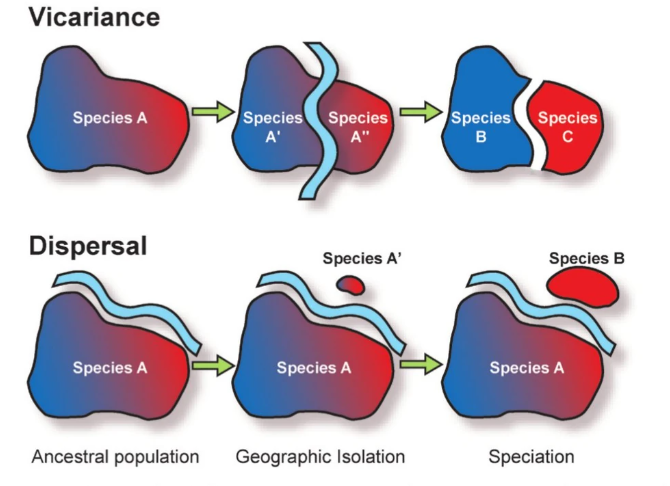evolution exam 3 - biogeography
1/19
There's no tags or description
Looks like no tags are added yet.
Name | Mastery | Learn | Test | Matching | Spaced |
|---|
No study sessions yet.
20 Terms
what did charles darwin believe about biogeography?
species are similar in similar areas and become more different as they move away from each other
what did wallace believe about biogeography?
he established wallace’s line to explain why, despite species being closely related, they’re still very different
2.6 mya - 11 kya, sea levels were lower, and land connected landmasses that are now separated by water today. therefore, species are close in genetic material, but are different due to population structure
what is a cosmopolitan species?
species that are widely distributed, even reaching multiple continents of oceans
what is an endemic species?
species that only exist in one area
more likely to be endangered, but not always
example, california poppies are endemic to california and widely abundant; california grizzly was once abundant and endemic but is now extinct
what type of place has the most species: an island or the mainland?
the mainland should have more species because it has more resources
what s the equilibrium theory of island biogeography? does it always hold?
due to dispersal, islands closer to the mainland will have more species, while islands farther will have less
does not always hold though, because evolution plays a big part in distribution/abundance of species
what is the latitudinal diversity gradient?
states that more species exist closer to the equator, and less species exist farther from the equator
due to resource abundance, warmer climate, and competition
what is the productivity hypothesis?
states that warmer climates lead to greater primary productivity, more plants and resources, and more niches
what is the diversification rate hypothesis?
states that as generations increase, more mutations are passed down, leading to a higher rate of evolution
in other words, more generations per unit time, the faster lineages can evolve
what is the time and area hypothesis?
states that there are more species in the tropics because the earth has been warmer for longer → if they disperse to a cold climate, they have to have a mutation that allows them to persist, which is rare
tropics are at the equator
what do these proposed hypotheses to support the longitudinal diversity gradient assume?
ancestral state lived in tropical climates, and the ability to live in cold climates evolved separately 3 different times, which suggests the mutation for living in colder climates is not favorable
what determines species distributions?
ecological factors
historical processes
ex: juniper has colonized a lot of canada and alaska → if someone takes it to a place with a similar climate, it will persist there
what are fundamental ecological niches?
all environmental conditions in which a species can exist and maintain stable population size
what are realized ecological niches?
where species actually exist
what would there be a disparity between fundamental and realized niches?
competition → may be able to exist elsewhere, but competition does not make it worth it, so a species stays confined to a place where there is less competition
what is phylogenetic niche conservatism? is this always true?
things that are more similar phylogenetically have similar niches
sometime strue, but not always
why do species distributions vary historically?
a lot of plant species evolved before continents diverged, so many trees in the americas and asia share the same genus and look identical
called disjunct distributions
what determines species distributions?
extinction, which can cause disjunct distributions
dispersal, which is movement of indivduals that can expand ranges
vicariance, which is separation of widespread species by barriers arising from geology, climate, or habitat

how can we determine the roles of dispersal and vicariance in shaping current species distributions?
paleontological data
phylogenetic data
what is the isthsmus and how did the formation of it affect land and marine animals?
ithsmus [of panama] was a narrow strip of land with sea on either side, forming a linke between two larger areas of land
enabled dispersal for land animals
enabled vicariance for marine animals